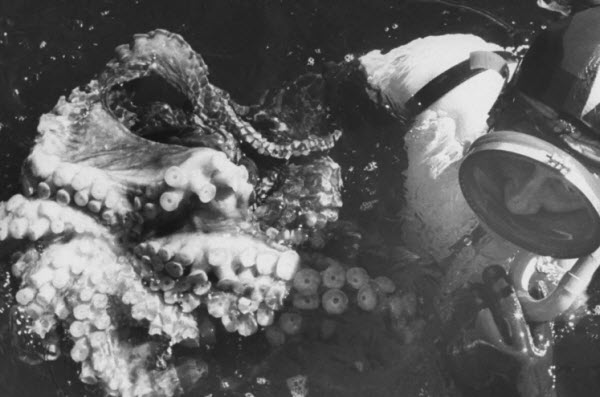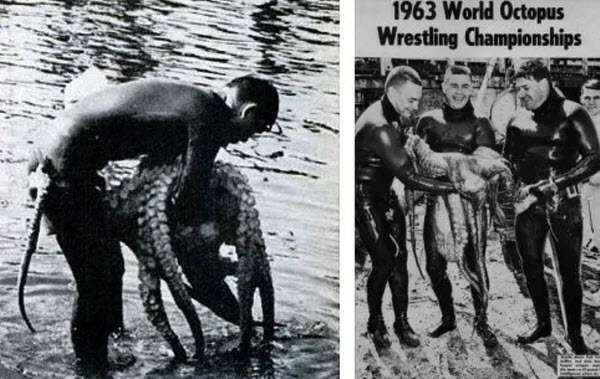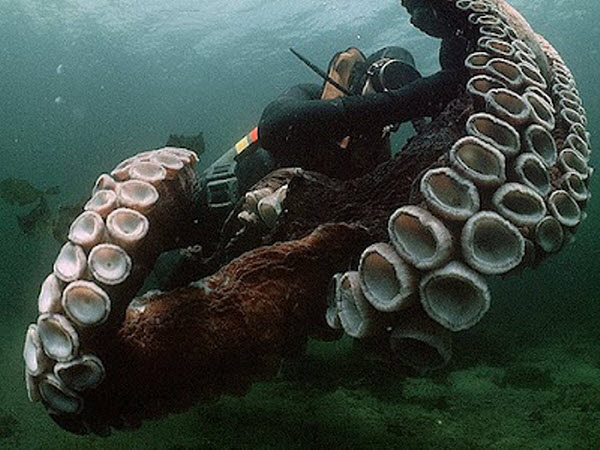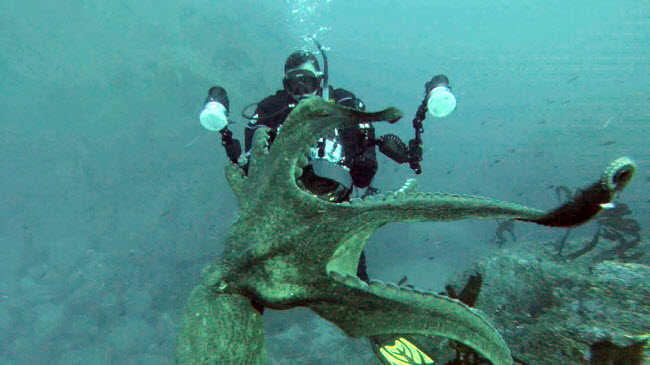In many legendary tales, it’s common for heroes to battle fearsome sea monsters with multiple tentacles in epic, breath-holding encounters. While these scenes are fantastical, some have sought to bring this dramatic imagery to life in the real world through a sport known as octopus wrestling. This unique and daring sport emerged in the United States between the late 1940s and mid-1960s. In octopus wrestling, participants dive underwater to search for this marine creature and engage in a fierce struggle to bring it to the surface and onto the shore, all while being watched by a captivated audience during an annual televised championship.
The origins of octopus wrestling can be traced back to the late 1940s. The first article about the sport appeared in “Mechanics Illustrated” in 1949, featuring a story about a man named Wilmon Maynard. Maynard boasted that his favorite hobby was wrestling octopuses, describing them as “the wily kings of the ocean with eight arms.” The article recounted how he assisted a local fisherman in Tahiti during a battle with a giant octopus in the clear depths of the ocean. According to the article, the conflict stemmed from a tribal leader’s belief that the octopus was a wandering ghost of an evil sea god named Tomo Rai Vino, who terrorized the seas with massive claws and sent legions of followers to destroy villages. This mythos fostered a culture of octopus hunting and wrestling within the tribe, a pastime that Maynard enjoyed with his partner, Ro. They would trap octopuses in the water, spear them, and return to the village to eat them. On one occasion, they faced a particularly massive octopus, and with the help of the entire village, they managed to defeat it. Maynard acknowledged that while some might view the sport as grotesque, he found it more enjoyable than hunting harmless creatures, claiming that wrestling and killing an octopus eliminated a treacherous sea foe.

After the story of Wilmon Maynard captured American media attention, octopus wrestling gained popularity among divers worldwide. By the end of World War II, there was a growing sense of adventure and a thirst for danger, fueled by science fiction and monster movies. The sea once again became a place for exploration and excitement, especially with innovations in diving equipment that played a significant role in the sport’s emergence.
As the years passed, octopus wrestling became a popular sport on the West Coast of the United States during the 1960s. The annual World Octopus Wrestling Championship took place in Puget Sound near Tacoma, Washington, and was broadcast on television, attracting up to 5,000 spectators. Divers, both individual and team, competed to capture the largest number of octopuses. The captured octopuses were either consumed, sold at fish markets, or returned to the sea. The largest octopus ever caught weighed 36 kilograms and was captured by a team from Portland, Oregon, in the 1957 championship.

Despite its name, octopus wrestling was not exactly a wrestling match. Most octopuses are somewhat temperamental and not aggressive unless provoked by humans. Typically, contestants would search for octopuses in crevices along ocean rocks, and once caught, they would pull them to the surface. The “wrestling” aspect was limited to subduing the creature until it surrendered. Although the sport was considered dangerous, there were no recorded fatalities. Veteran octopus wrestler Gary Keifler noted that octopuses lacked the strength to kill a human.
The sport reached its peak in 1963, with 11 divers participating and attracting thousands of spectators to the beach. A total of 25 giant octopuses were captured from the Pacific Ocean, weighing between 1.8 and 25.9 kilograms. However, the event faced challenges due to the number of contestants exceeding the number of octopuses in the area. Organizers had to place previously captured octopuses along the shore to ensure a successful event, especially as it was broadcast on television. The sport faced criticism due to the long periods of underwater activity and the eventual return of the diver with the captured octopus, which led to diminishing enthusiasm among spectators. The sport continued for several years but was eventually abandoned and banned in most parts of the country.

Though no longer an accepted sport, octopus wrestling still occurs occasionally. In 2012, diver Dylan Meyer from Puget Sound made headlines by capturing an octopus and bringing it to shore. Despite the ban on the sport, divers are still allowed to catch one octopus daily for food, which led Meyer to eat the octopus to comply with regulations. His actions reignited debates about the ethics of the sport and animal rights.
